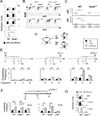Constraints contributed by chromatin looping limit recombination targeting during Ig class switch recombination
- PMID: 25624452
- PMCID: PMC4440573
- DOI: 10.4049/jimmunol.1401170
Constraints contributed by chromatin looping limit recombination targeting during Ig class switch recombination
Abstract
Engagement of promoters with distal elements in long-range looping interactions has been implicated in regulation of Ig class switch recombination (CSR). The principles determining the spatial and regulatory relationships among Igh transcriptional elements remain poorly defined. We examined the chromosome conformation of C region (CH) loci that are targeted for CSR in a cytokine-dependent fashion in mature B lymphocytes. Germline transcription (GLT) of the γ1 and ε CH loci is controlled by two transcription factors, IL-4-inducible STAT6 and LPS-activated NF-κB. We showed that although STAT6 deficiency triggered loss of GLT, deletion of NF-κB p50 abolished both GLT and γ1 locus:enhancer looping. Thus, chromatin looping between CH loci and Igh enhancers is independent of GLT production and STAT6, whereas the establishment and maintenance of these chromatin contacts requires NF-κB p50. Comparative analysis of the endogenous γ1 locus and a knock-in heterologous promoter in mice identified the promoter per se as the interactive looping element and showed that transcription elongation is dispensable for promoter/enhancer interactions. Interposition of the LPS-responsive heterologous promoter between the LPS-inducible γ3 and γ2b loci altered GLT expression and essentially abolished direct IgG2b switching while maintaining a sequential μ→γ3→γ2b format. Our study provides evidence that promoter/enhancer looping interactions can introduce negative constraints on distal promoters and affect their ability to engage in germline transcription and determine CSR targeting.
Copyright © 2015 by The American Association of Immunologists, Inc.
Figures




References
-
- Schatz DG, Ji Y. Recombination centres and the orchestration of V(D)J recombination. Nature reviews. Immunology. 2011;11:251–263. - PubMed
-
- Chaudhuri J, Basu U, Zarrin A, Yan C, Franco S, Perlot T, Vuong B, Wang J, Phan RT, Datta A, Manis J, Alt FW. Evolution of the immunoglobulin heavy chain class switch recombination mechanism. Adv Immunol. 2007;94:157–214. - PubMed
Publication types
MeSH terms
Substances
Grants and funding
LinkOut - more resources
Full Text Sources
Other Literature Sources
Research Materials
Miscellaneous

